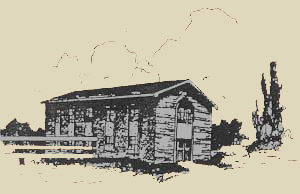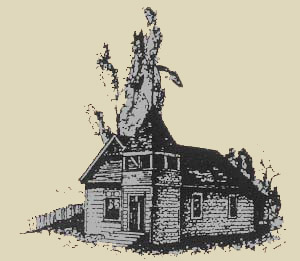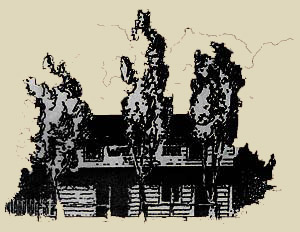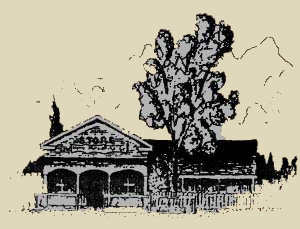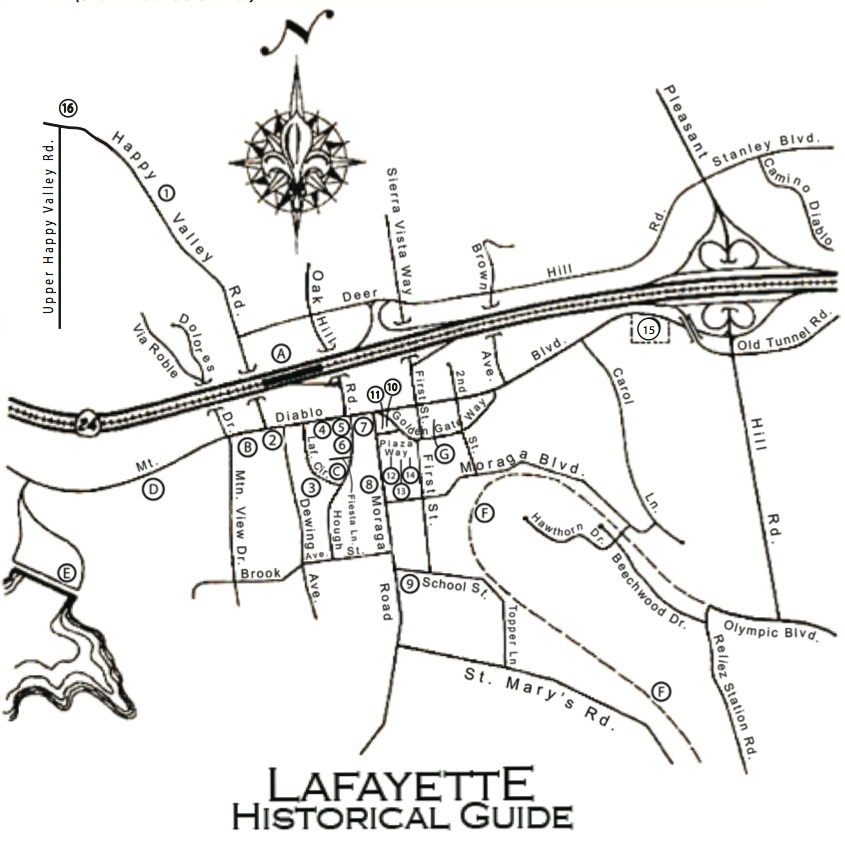Includes Pioneer Structures and Sites Plus Modern Facilities
The Early Days
Brown’s Mill, Brown’s Corners, Centerville, La Fayatte – the suburban community of Lafayette, California has had many names. It was officially granted the name Lafayette in 1855 when Benjamin Shreve, the town’s first school teacher, applied for a post office for the village.
Located on land that once encompassed an entire Mexican land grant (Acalanes Rancho) and portions of four others, Lafayette was first settled in 1848. While the original land grant was made in 1834 to Candelario Valencia, the town founder was the third Rancho owner, Elam Brown. He bought the one square league Rancho for $900.
As the hamlet straddled the road that led from the Moraga Redwoods to the lumber shipping point at Martinez, early Lafayette became a stop-over spot for wagon drivers. When Brown established a grist mill in 1853, the center of the farming village moved toward the present Mt. Diablo-Moraga Road intersection.
Lafayette remained a quiet farming village until the post-World War II building boom turned cornfields into housing developments.
The City of Lafayette was incorporated in 1968 and is today home for more than 20,000 suburbanites.
Legend of Historic Sites
- Site Juan Bernal home (1/2 mile up Happy Valley Road, west side) Built by Juan Bernal, co-grantee of Rancho Laguna de los Palos Colorados, 1846. Razed after suffering severe damage in 1906 earthquake.
- Site James Bickerstaff home (3615 Mt. Diablo Blvd) Redwood tree still standing in parking lot planted by his daughter, pioneer school teacher Jennie Bickerstaff Rosenberg.
- Site Sakalan Indian Burial Grounds (Oakland Avenue-Lafayette Circle) Discovered during construction excavation 1970.
- Garrett Building (3565 Mt. Diablo Blvd) Unusual design constructed 1920 by realtor, Colonel N.M. Garrett.
- Small Red Frame Building (201 Lafayette Circle) Formerly on corner facing Mt. Diablo. Built circa 1920. Formerly restaurant, saloon, newspaper office.
- Site Elam Brown house (32 Lafayette Circle) Built circa 1849 by town founder. Razed in 1929.
- Second School House (3535 Mt. Diablo Blvd.) Built 1871. Originally located behind Lafayette United Methodist Church. Moved to present location in 1927. Still in use.
- Third School House (955 Moraga Rd.) Since 1927 the nucleus of the Lafayette United Methodist Church. Original school and belfry built in 1893, easily identifiable. Deodor cedars in front planted by pioneer residents Robert and Gertrude McNeil.*
- Town Hall (corner Moraga Rd. & School St.) Built 1914 as social, entertainment hall by Lafayette Improvement Association and local residents. Used as theatre today.*
- Elam and Margaret Allen Plaza Park (southeast corner Mt. Diablo Blvd. and Moraga Rd.) Triangle of land, originally five times present size, donated to town as public plaza by Elam Brown, 1852.**
- Grist Mill Wheel (attached to wall of Plaza Park as memorial to Elam Brown) Wheel taken from Brown’s grist mill when it was dismantled in 1880.**
- Pioneer Store (3535 Plaza Way) Benjamin Shreve’s store, insurance agency and the post office, opened early 1860’s. Named Pioneer Store by Robert Elam McNeil who bought the store in 1902.**
- Geils Building (3531 Plaza Way) Built 1880’s as a tavern by Fred Geils. Has housed a variety of businesses.**
- Way Side Inn (3521 Golden Gate Way) Built in 1898 as hotel and tavern. Has housed a variety of businesses.**
- Lafayette Cemetery (near intersection of Mt. Diablo Blvd. & Pleasant Hill Rd.) Land sold for $100 by Medford Gorham to cemetery corporation 1874.**
- Site of Elam Brown’s First Home (built in 1848 along a creek on Happy Valley RD.).
Legend of Contemporary Sites
A. BART Station (Deerhill Rd. between Happy Valley Rd. and Oakhill Ave.)
B. Post Office (Mt. Diablo Blvd. opposite Happy Valley Rd.)
C. Lafayette Chamber of Commerce (100 Lafayette Circle)
D. Lafayette City Offices (3675 Mt. Diablo Blvd.)
E. Lafayette Reservoir – recreation area
F. Lafayette – Moraga Trail (Formerly Sacramento Northern Railroad right of way)
G. Lafayette Library & Learning Center (3491 Mt. Diablo Blvd.), Friends Corner Bookshop & LHS History Room (enter on Golden Gate Way)
NOTE: Map locations marked ** have been declared Points of Historical Interest. These places, plus those marked *, have been plaqued by the Lafayette Historical Society with the assistance of the Rotary Club of Lafayette, Lafayette Lions Club, Soroptimist Club of Lafayette-Orinda, Methodist Community Church, and Alice McNeil Russi.
